What are SMART goals?
HR management is a complex field of professional activity. After all, it is difficult to predict and calculate everything 100% in it because this activity has human emotions and inaccuracies.
But still, certain methods will help to achieve goals and predict certain processes.
The SMART goal technique is a method of setting goals. It allows you to formulate a realistic and measurable plan, and determine the terms and necessary resources for its achievement—an example of a SMART goal: close 10 technical vacancies in 1 month.
This method has certain specific characteristics:
- Specificity. Be specific about your goal and narrow down the details: the who, what, where, and when you want to achieve. You should set realistic goals for yourself.
- Measurability. Set clear benchmarks to monitor whether you are making progress. Go for your success, but as needed in the process, change these criteria and make them more realistic.
- Achievable. Make sure the goal is reasonable given your resources and available time frame.
- Relevance. The purpose must be consistent with the long-term goals and values of the department and the organization as a whole.
- Time-bound. Set a realistic end date to prioritize the goal and motivate the people working on it.
The SMART method is used in many fields of activity, but it is also quite effective in the HR field.
Only some people know how to correctly set goals in the field of personnel management, but we are sure that everyone can learn it.
Why should HR professionals set SMART goals?
HR specialists need to learn to set SMART goals because it helps always to keep the HR department in good shape, and to give them an understanding of where they are going and why. Setting goals for employees affects both individual and collective productivity. A specific goal motivates employees to be involved in everyday work and processes that take place in the company. When employee skill development and goals are aligned with business goals, it ultimately drives company growth.
Setting goals in the workplace can also lead to better retention rates: 94% of employees who quit say they would stay if their company invested more in employee training. Promoting skills development and continuous learning as part of a goal-setting strategy can help reduce staff turnover.
Of course, for the setting of goals to have a positive effect on the development of employees and the growth of the company, these goals must be set correctly and exclusively according to the SMART model. With goals that are specific, measurable, attainable, relevant, and timely, even the best-laid plans can stay intact.
HR SMART goals help the HR department quantify their requirements, so they clearly understand what they need to request from management, be it budget or resources, to achieve their goals.
In the same vein, HR SMART goals also help quantify results such as percentage contribution to the overall growth of the organization in terms of brand enhancement, better employee feedback, and improved skill pool.
When consistently followed, SMART goals give a company culture a big push in the right direction, making it attractive to both prospective candidates and investors.
Specific goals direct the efforts of employees, motivate them to perform, and increase efficiency. Correctly set goals help employees to fully reveal their potential and help businesses to achieve global goals.
That`s why the role of correct goal setting for employees is huge. We recommend that all HR specialists learn to do it correctly and use it more often in strategic planning.
By the way, automated HR systems also help in setting goals correctly. Sign up today and get a free 1-month demo version of Brainy HR
HR Smart Goal Example
A small company purchased a new CRM platform for its sales managers. The main goal is to increase productivity and minimize manual tasks. To use CRM as effectively as possible, the management plans to train employees to use the system under the supervision of instructors for sales managers.
A SMART goal will look something like this:
Specificity. A group of ten sales managers undergo instructor-led CRM training to learn how to create opportunities in CRM.
Measurability. N hours saved per day by each sales manager after using CRM software.
Achievable. Discussion and re-evaluation of the training with previous participants led us to the conclusion of the need to create instructor-led training for a smaller group of people at the same time.
Relevance. CRM training will help our sales managers use the tool to its full potential, giving us a maximum return on investment.
Time-bound: 35 days of training.
Summary
Correct goal setting is half the success. After all, even the most desired dreams and goals may not be achieved due to the incorrect distribution of forces and resources. Therefore, it is necessary to start with the correct setting of goals. One of the most common and effective techniques is the SMART goal-setting technique. This technique is used in many areas, including HR. In the field of personnel management, specialists need to learn how to correctly set goals for employees and achieve them. After all, it affects each employee's individual development plan and the business's development as a whole.
Automated HR systems can also help with this process. Sign up today and get a free 1-month demo version of Brainy HR software.


 Posted on Nov 9, 2022 by Lillia
Posted on Nov 9, 2022 by Lillia


